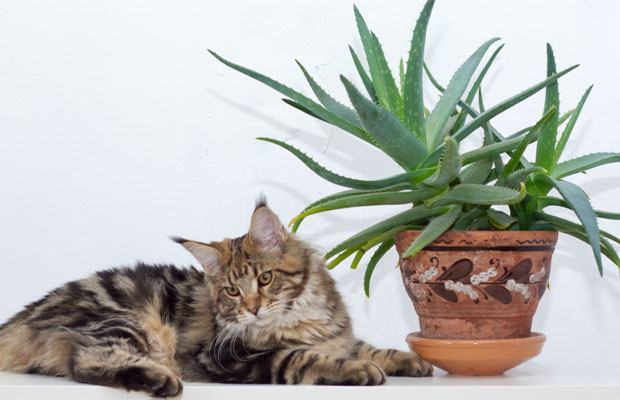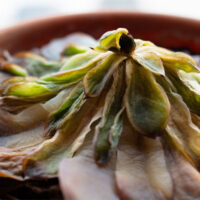If you have a pet and want to know whether succulents are dangerous to your pet, then you’re in the right place! We will list what succulents are poisonous to your dogs and cats, and also list some safe succulents that you can plant safely.
Due to their ease of maintenance and suitability as indoor plants, succulents are a popular choice.
Are succulents poisonous to cats and dogs? Ideally, your pets aren’t damaging your plants by chewing on them or digging them up for fun. The euphorbia genus contains numerous succulents that are toxic to both cats and dogs, including the pencil cactus and crown of thorns.
Ingestion of this succulent can cause a variety of poisoning symptoms, including gastrointestinal distress and skin and eye irritation. Keep reading and find our more!
Table of Contents
Succulents That Are Poisonous To Dogs And Cats
Avoid the following succulent varieties if you live with a dog or cat.
Aloe Vera
Toxicity: to dogs, cats, horses
Aloe is a large and well-known genus that includes small dwarf species and large tree-like species that can reach heights of up to 30 feet (10 meters). They have thick, fleshy, green to bluish-green leaves. On the surfaces of some varieties’ stems, there are white flecks.
Aloe vera is toxic to both cats and dogs when consumed, despite the fact that it has many medicinal and helpful properties for humans. Aloe’s main toxin, saponin, which is a substance found in it, can seriously harm your pet’s health.
Clinical symptoms of poisoning: abdominal pain, diarrhea, nausea, vomiting, skin irritation, lethargy, and tremors.
Euphorbia Milii
Toxicity: to dogs, humans
These succulents, which are native to Madagascar, are well suited to growing inside. Their flowers, which are typically red, pink, or white in color and can reach heights of up to two feet, are what make them valuable. These plants have a ½ inch-long row of sharp thorns covering them.
The plant is known by the name “Crown of Thorns,” which is derived from the biblical account of Christ’s crucifixion and refers to the fake crown that was placed on Jesus’ head at that time.
Accidental poisonings are uncommon because these plants are so prickly and bitter. The plant’s white, milky sap, known as latex, has the highest level of toxicity, though any part of the plant can irritate the skin. In addition to being poisonous when eaten, the plant irritates the skin.
Use the appropriate safety measures when working with these plants. Itchy skin can result from the sap that leaks from broken stems or leaves.
Symptoms include: nausea, vomiting, and diarrhea when ingested; skin irritation, dermatitis from skin contact. Dogs may also develop blisters and swelling near their mouths and eyes.

Euphorbia Tiruacalli (Firestick, Pencil Tree Plant, Pencil Cactus)
Toxicity: to dogs, cats, horses
Over 2,000 species make up the sizable succulent genus Euphorbia. The majority of euphorbias are indigenous to Madagascar and Africa. The Euphorbia Tiruacalli (Firesticks, Pencil Tree) has cylinder-shaped branches and tiny, slender leaves.
Their hues range from green to orange-red, and they become more vibrant during the colder winter months. The sap from the plant is the main irritant.
Clinical symptoms include: mild irritation to the mouth and stomach, may cause vomiting (symptoms are often mild and not severe)
Kalanchoes
Due to their beauty and simplicity of maintenance, kalanchoes are common indoor plants. There are hundreds of beautiful, flowering plant species in the genus Kalanchoe. They grow eye-catching flowers, making them well-liked ornamental plants.
Cats, dogs, and other animals are known to be poisoned by kalanchoes. Because of the bufadienolides cardiac glycosides found in these plants, abnormal heart rhythm, severe weakness, and irregular heartbeats can result.
Some popular Kalanchoe houseplants that are toxic to pets:
Kalanchoe Tomentosa (Panda Plant)
Toxicity: to dogs, cats
Panda plants are perennial shrubs with furry grayish green leaves that have white hair and some brown spots on the margins and tips. Popular houseplants because of their elegance and simplicity of maintenance. When ingested, the Kalanchoe Tomentosa (Panda Plant) is poisonous in all parts.
Common symptoms include: vomiting, diarrhea and lethargy. Ingesting large quantities of the plant can be fatal.
Kalanchoe Daigremontiana (Mother Of Thousands)
Toxicity: to cats, dogs, cows, birds
These are native to Madagascar and are also known as Bryophyllum Daigremontianum (also known as Mother of Thousands, Alligator Plant, or Mexican Hat Plant). Having large, green leaves that develop into baby plantlets along the edges, Mother of Thousands are attractive, unusual-looking plants.
Due to their rapid growth, these plantlets are known to spread wherever they land and can be challenging to eradicate. In some places, these plants are regarded as invasive weeds and a nuisance by some.
Once established, these plants are tolerant of extreme heat and hardy. Daigremontianin, a poisonous steroid found in the plant,
Common symptoms include: vomiting, diarrhea, weakness; and in rare occasions: abnormal heart rate, tremors, seizures, collapse
Kalanchoe Delagoensis (Mother Of Millions, Devil’s Backbone, Chandelier Plant)
Toxicity: to dogs, cats, other pets, grazing animals
These plants, also known as Bryophyllum Delagoensis, grow quickly and are known to multiply readily wherever they land, earning them the title “Mother of Millions.” They result in tiny plantlets that sprout from the plant’s ends.
These plantlets can grow continuously wherever they land, and even if the plants are removed, the seeds can persist for many years.
These plants are not only drought tolerant but also highly adaptable to various environments. In some regions of the world, they are regarded as weeds or invasive species. They contain bufadienolide cardiac glycosides, which, in high doses, can be fatal. Usually mild to moderate toxicity, but rarely severe toxicity, is present.
Clinical symptoms include: gastrointestinal irritation or upset, vomiting, diarrhea, abnormal heart rhythm (rare), there is a higher risk of more severe symptoms if large amounts are ingested.
Crassula Ovata (Jade Plant)
Toxicity: to dogs, cats
Large succulent plant species belong to the genus Crassula. South Africa and Mozambique are the native home of jade plants. One of the most well-known and widespread succulents is the jade plant, also known as the money tree, lucky plant, or friendship tree.
Their distinctive leaves, which develop in opposite pairs, are thick, fleshy, shiny, and smooth. Jade plants are poisonous for reasons that are unknown.
Common symptoms include: vomiting, depression, incoordination, lethargy
Crassula Arborescens (Silver Jade Plant)
Toxicity: to dogs and cats
South Africa is the home of the Crassula Arborescens, also referred to as Silver Jade, Chinese Jade, or Money Plant. Their “silver dollar” leaves, which are round, silvery-green in color, and have reddish edges, serve as a identifying trait. Unknown toxic substance.
Symptoms include: nausea, vomiting
Sansevieria Trifasciata (Snake Plant, Mother-in-law’s Tongue)
Toxicity: to cats and dogs
Native to West Africa, Sansevieria trifasciata is also referred to as the snake plant or mother-in-law’s tongue. They have upward-pointing, long, slightly windy leaves. Some varieties of the leaves have yellow edges, but most are primarily green.
Because of their resistance to abuse, these plants make excellent starter plants. Snake plants are well known for removing formaldehyde and benzene toxins from the air in your home, which helps to purify the air. The irritating chemical found in snake plants is saponin, which is also present in many other plant species.
Symptoms include: nausea, vomiting, diarrhea when ingested
Senecio Rowleyanus (String Of Pearls, String Of Peas Plant)
Toxicity: to dogs, cats, other pets
These plants, which are native to South Africa, are well-known for their adaptability and trailing behavior. The stems can be left hanging or trailing and can reach a maximum length of 3ft (90cm). Small, rounded, pea-like green leaves line the stems of the plants.
For their beauty and unique appearance, these plants are highly sought-after. They grow white flowers that are fuzzy and smell sweetly of cinnamon and vanilla. These plants require protection from direct sunlight and are not frost tolerant.
The sap of this plant can irritate both people and animals’ skin, according to the University of California, Davis.
Symptoms include: vomiting, diarrhea, drooling, lethargy when consumed by animals
Read More: How To Plant Succulents?
Succulents That Are Safe For Cats And Dogs
If you are really looking to expand your plant collection and think succulents are the way to go,you can consider the following:
Hens And Chickens
Hen and chickens, also referred to as houseleek, are among the most well-liked succulents for a good reason.
They are renowned for requiring little care and flourish in a variety of settings, including succulent wreaths, rock gardens, and planters. The main plant—aka the “hen”—is connected to the smaller offshoots (her “chicks”) through small, delicate roots, making for a visually appealing display.
Haworthi
Consider a haworthia if you like the spiked shape of aloe vera. This simple-to-grow succulent, also referred to as the zebra cactus, looks similar but is harmless to animals.
Burro’s Tail
The burro’s tail is ideal for displaying in hanging planters and on shelves because it has lush trailing tendrils. Some plants will offer pink or red flowers under ideal summertime conditions even though they don’t typically bloom.
How To Keep Cats And Dogs Away From Succulents?
Cats are experts at finding exactly what we don’t want them to. The best course of action is to completely banish poisonous succulents from the home. Because your cat might decide to munch on those wells, keep safe succulents out of the cat’s reach if you can. You can also use a safe mixture of vinegar, lemon (or other citrus juice), and water to mist your succulent plants to deter cats.
How To Protect Your Pets From Toxic Plants?
The best way to keep your pets safe is to know which plants are poisonous to dogs and cats and to avoid bringing them into your home. This is especially important in today’s world of thousands of varieties of succulents and increased accessibility to exotic plants.
Check both the toxicity list and the extensive database of poisonous plants maintained by the ASPCA before making a purchase of a new plant.
If you already have plants in your house and garden, check to see if they are safe for animals before using them.
It’s also crucial to keep in mind that any plant, poisonous or not, can harm animals.
Even non-toxic plants can upset the stomach when consumed, particularly in animals with sensitive stomachs. Other plants may even have chemicals or pesticides on their leaves, which can further harm animals. Always try to prevent pets from eating indoor plants.
It is advantageous for pet parents to be familiar with the names of every plant in their residence, including both nicknames and Latin names.
The best thing you can do in this situation is to identify the plant in question before your pet eats one of your nontoxic plants, or if your pet eats a plant that might be poisonous while out for a walk or while visiting a friend.
Many dangerous succulent species would be difficult for veterinarians to identify. It is best to be familiar with the plants in your house, and if a pet ingests one you are unsure of, look it up right away to check for potential toxicity and call your veterinarian right away.
You can educate yourself about some of the most popular poisonous plants for dogs and cats that grow in your area or that friends may have as houseplants before an incident occurs.
Read More: Is Lavender Bad for Dogs?
FAQs
Are Echeveria Toxic to Cats?
No, it is safe to cats.
Are Succulents Poisonous to Babies?
Two succulents that may be toxic to humans are Kalanchoe and Euphorbia.
Is Haworthia Toxic to Cats?
It is nontoxic to cats.

















